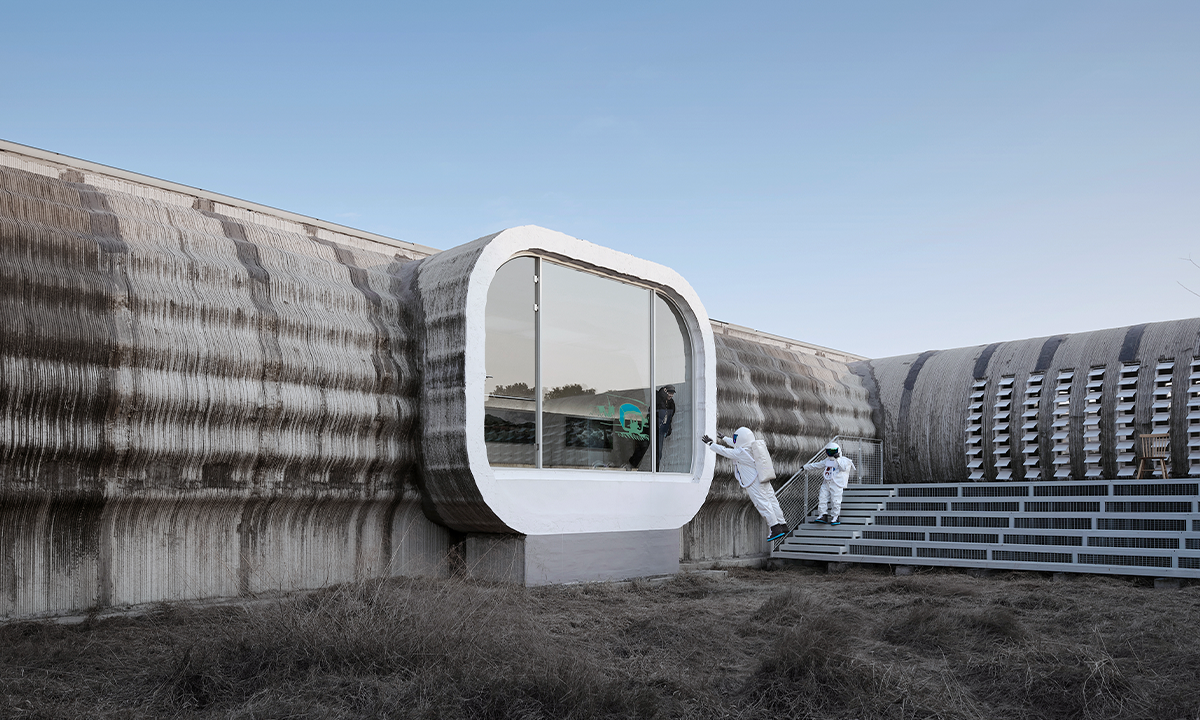
A wide view of Tian Art Gallery, a 3D-printed art gallery located in Zhouquan town, East China's Zhejiang Province Photo: Courtesy of Tian Art Gallery
Xu Xueying, a 40-year-old photography enthusiast, lives in a village in Zhouquan town, East China's Zhejiang Province. Like many people her age, she loves capturing the local natural flower fields and people. Yet lately, her photos have started featuring a rarely seen addition - a building she describes "surreal," a concrete-style art gallery that rises from the village's wild greenery.
Named Tian Art Gallery, the "surreal" space has recently opened to the public. What makes it special lies not only in its offbeat location - built within a pigsty, but also in its construction using 3D-printed concrete technology. With its grey-toned exterior and futuristic modular design, the building might initially seem at odds with the surrounding rural landscape. Yet it is gradually becoming an integral part of the rural scene, aiming at revitalizing the community by hosting cultural events and fostering village tourism.
'Not a gimmick' This new architectural space spans approximately 1,200 square meters in total floor area. At first glance, its structure consists of several hollow cylindrical tubes, arranged in a connected composition. Li Yikao, the project's lead and head of the Leeko Studio said that the pipe-like design echos to the traditional agricultural irrigation system, reflecting a respect for the rural way of life and its underlying ecosystem.
The goal to preserve the village's ecosystem is reflected not only in the building's form, but also in its materiality. The museum incorporates construction waste, industrial slag, coal cinder, and urban solid waste as raw materials, exploring the potential of recycled building materials in a countryside setting.
The architect describes this experiment as a designer's "act of trying," for which he has been consistently exploring on how the unique local culture of Chinese villages can inspire architectural creativity.
"There was a time when mentioning urban areas would inevitably evoke a sense of superiority. Yet in recent years, with the distinctive development of China's countryside, rural settings have become as equally vital and modern as cities," Li told the Global Times, adding that Chinese rural areas are even "capable of fulfilling people's spiritual and creative needs" that urban environments often fail to satisfy.
Perhaps recognizing the creative potential embedded in Chinese rural landscape, Li and his team transformed the Tian Art Gallery project into what is now the world's largest single-structure and 3D-printed art gallery.
Although the 3D building has been described by villager Xu as a "rocket science," Li, the architect explained that its underlying logic was remarkably simple, the same as how "to write with ink on paper."
The printer used for the project resembles a dock crane, Li said. It was installed on-site, and the machine began its work once the X and Y axes for printing were determined. Thanks to its efficiency, the construction of the world's top 3D-printed art museum was completed within less than a week. Compared to traditional building practice that engages expensive materials and labor, the building's construction cost was around 3,000 yuan (about $413) per square meter.
"3D printing is not a gimmick, but a solution that leverages technology and creativity to address rural construction challenges," Fellow architect Zhu Xing told the Global Times, adding that the "tech and creativity" combo defines an "emerging pathway to rural development."
New revelations The "tech and creativity" pathway to rural revitalization, as observed by Zhu, seems to transcend being a mere "emerging" trend, evidenced by its ongoing implementation in different Chinese villages.
Located about four hours' drive way from Xu's hometown in Lishui's Songyang county, imaginative cliff-based architectural designs have transformed a remote 600-year-old village into a leisure spot boasting a cafe, library, and art space. Far from just Zhejiang Province, Yangzheng Library in a village in Northwest China's Gansu Province has been built as the country's first carbon neutral reading facility.
Keiichiro Sako, lead architect of the library project, told the Global Times that the project that can achieve a 166 percent comprehensive energy efficiency, was not aimed at showcasing how good the architecture is. Rather, it focuses on providing the local people with a gathering venue while encouraging them to gain a more sustainable village life.
"Projects like this should be able to serve the locals with more cultural events and community interactions," Sako remarked.
Whether it's the 3D-printed art space or the zero-carbon library, such buildings are not just design showpieces, but catalysts for villages' cultural activities.
This explains why the Yangzheng Library now hosts reading programs for rural youths, while the 3D gallery will become a "launchpad for the village to develop visual arts-related cultural tourism," Yuan Haixing, a staff member of the Zhouquan town People's Government, told the Global Times.
Beyond currently hosting 166 pieces of rural-themed photographic artworks in its ongoing exhibition, other programs such as "photography training courses" and "paper-cutting art exhibition" are already scheduled to take place one after another, Yuan said. She added that all these initiatives were aimed to boost the local's rural tourism.
Through multiple visits to the gallery, photographer Xu has finally discovered that a sweeping aerial shot can most powerfully captures the gallery's beauty. She now knows the site very well, but still said that the space never fails to surprise her with new revelations whenever she walks by.
"Some older village folks told me they cannot quite get the project for now, but I like to see projects like growing from the green field, making me see the possibilities of my hometown," Xu noted.

A photo shows the exterior design of Tian Art Gallery Photo: Courtesy of Leeko Studio





